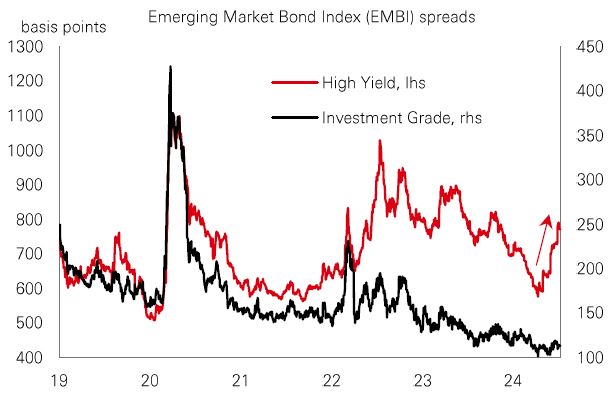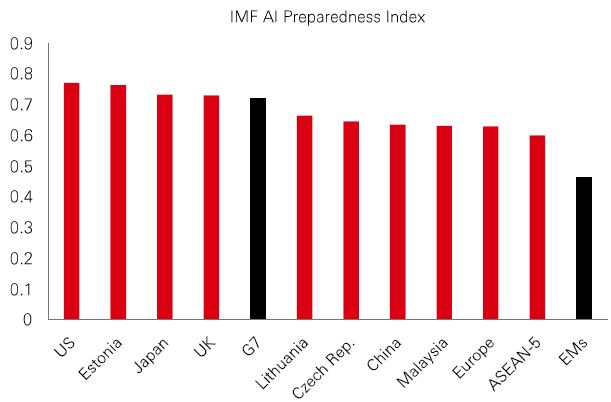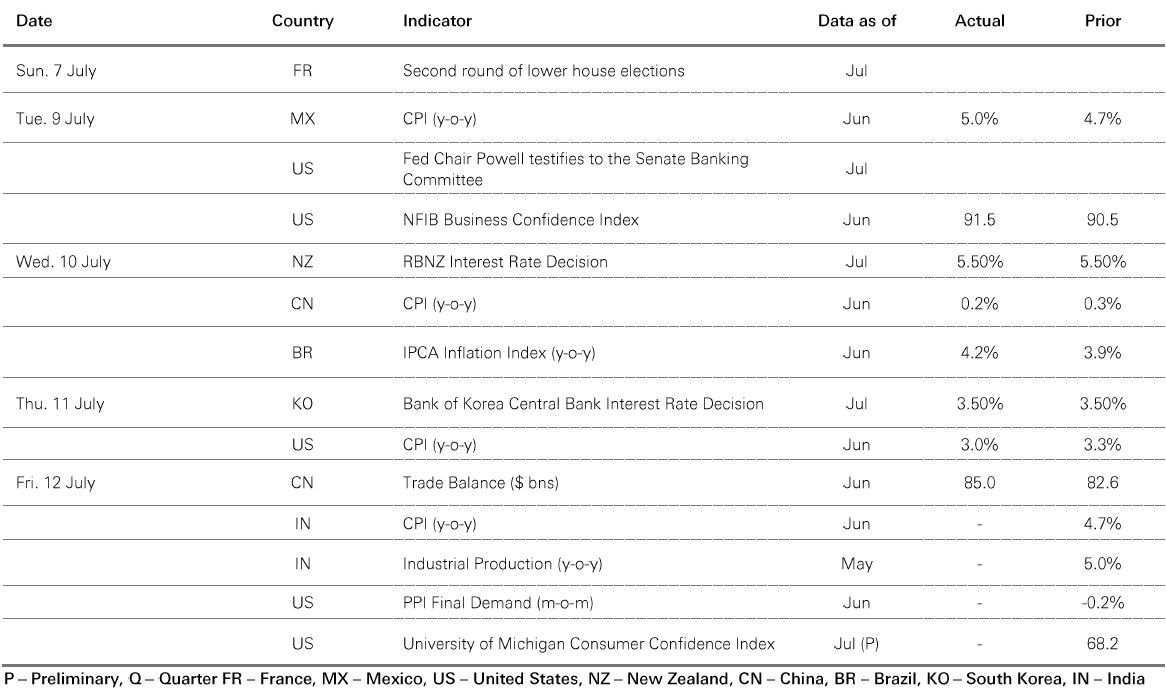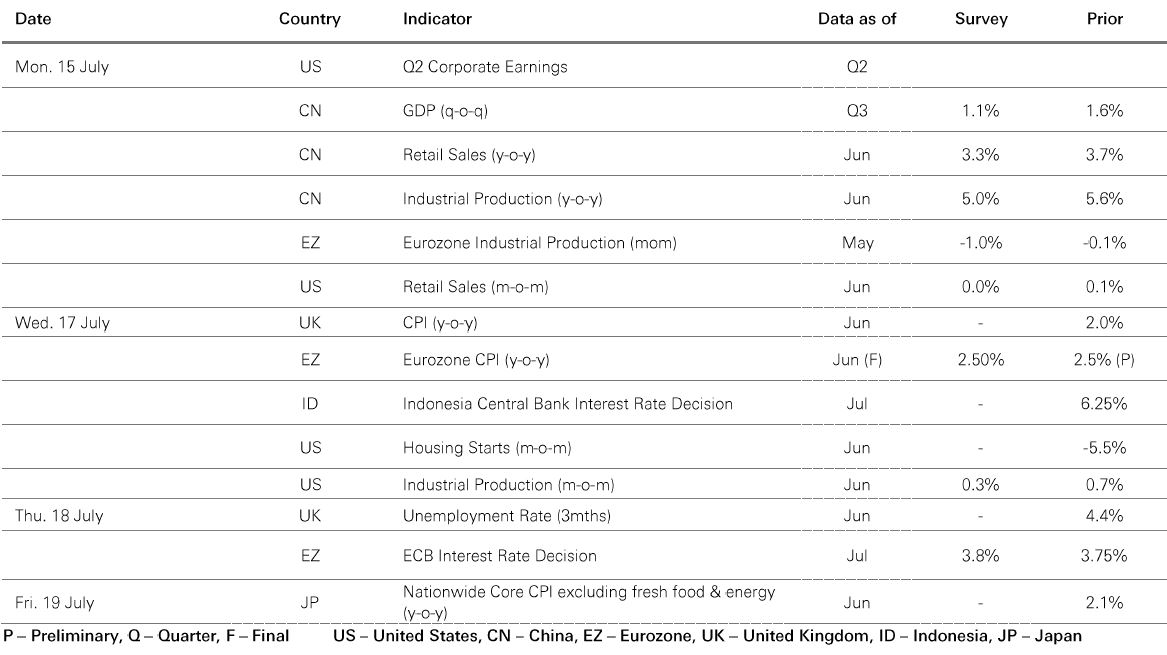
15 July 2024

Coming into 2024, investors were convinced that central banks were poised to slash rates. Yet, resilient growth and sticky inflation have, so far, put paid to that. And for core bond markets, the spectre of ‘higher for longer’ policy has delivered a poor performance. But it could change in H2.
Four years of rising yields on 10-year US Treasuries reflect what has arguably been the worst bond bear market ever. The Bloomberg Aggregate Index – a barometer of the broader bond universe – is in its deepest, longest drawdown since its inception in 1976. But now, a starting point of high yields provides scope for significant capital growth.
That’s because signs of cooling in the US economy could finally prompt the Fed to pivot policy in the near-term. Last week's June CPI inflation print came in below expectations, with key components such as shelter and auto inflation softening. Meanwhile, the unemployment rate rose for the third month in a row in June, hinting that wage growth – an important driver of services inflation – is likely to decline further. Other data suggest weakness in rate-sensitive sectors like housing. And retail sales softened in Q2, amid rising delinquency rates for lower income households.
There are risks, of course, including a potentially bumpy path for disinflation and geopolitical and election headwinds. Even so, there may be an opportunity to ‘play the yield’. And with inflation heading back to target, there is the possibility that bonds return to their traditional role as defensive portfolio diversifiers.
Surging price momentum in the technology sector has driven growth stocks to new highs this year. And over the past five years, the US Growth factor has outperformed Value by around 95 percentage points.
But it’s worth remembering that markets can quickly blow the froth off prices when earnings disappoint. In late 2021, the price-earnings (PE) ratio of the S&P 500’s seven largest tech stocks hit a high of 36x. By January 2022, that valuation had collapsed by 15% as the market levelled out and cheaper stocks rebounded. By June, their combined PE had fallen to 24x. And with that in mind, the current PE valuations of the Magnificent Seven stocks are the most stretched they’ve been since December 2021 – at 34x versus the rest of the S&P on 18x. Excessive valuations create a vulnerability to anything short of exceptionally good news.
As for Value, unloved sectors like utilities and staples, as well as small-caps generally, have lagged the market of late. But if earnings begin to disappoint elsewhere, they could offer a more defensive option for portfolios, and should be well-placed to attract market interest once the Fed begins to cut rates.
The value of investments and any income from them can go down as well as up and investors may not get back the amount originally invested. Past performance does not predict future returns. The level of yield is not guaranteed and may rise or fall in the future. Investments in emerging markets are by their nature higher risk and potentially more volatile than those inherent in some established markets. This information shouldn't be considered as a recommendation to buy or sell specific sector/stocks mentioned. Any views expressed were held at the time of preparation and are subject to change without notice. Source: HSBC Asset Management. Macrobond, Bloomberg.Data as at 11.00am UK time 13 July 2024.
Like many fixed income asset classes, the year-to-date performance of emerging market (EM) bonds has been hamstrung by delays to the Fed easing cycle. For the benchmark EMBI (index of US dollar-denominated bond issued by EM sovereigns and state-owned firms), there has been a particularly sharp increase in the spreads in the high-yield (HY) component.
There is a good chance that HY spreads will tighten again once the Fed starts cutting rates. EM investment specialists also see room for credit rating upgrades amid solid and improving fundamentals. The Dominican Republic for example (BB- rating) has solid external buffers and fiscal policy anchors which could support lower levels of debt to GDP.
Meanwhile, the investment-grade component, while less attractive on a stand-alone spread basis, still benefits from elevated “all-in yields” and high credit quality.

Profit growth estimates for Chinese and US stocks had an intriguing coming together the previous week – with analysts forecasting growth of 13% in both markets over the next 12 months.
The last time we saw this kind of convergence was in September 2021 – just as analysts were slashing forecasts for US stocks on rising inflation. Since then, sentiment across the two markets has diverged. For US stocks, growth forecasts continued to drop until profit recovery took hold in early 2023. But in China, average profit growth expectations have stayed in the mid-teens throughout.
While Chinese profit growth has been resilient, the local equity market has underperformed. In part, this has been down to macro concerns like weak consumer demand and a faltering property sector. But recent policy support for priority sectors and positive corporate reforms have helped – and there are hopes that this week’s third plenum meetings will go further. As it stands the valuation of Chinese equities remains below its longer-term average, and materially below DM and EM peers. But with improving news on the macro and earnings outlook, a re-rating is possible.

When OpenAI launched its ChatGPT chatbot in 2022, it sparked huge interest in how artificial intelligence might transform productivity. Tech firms are estimated to be spending more than USD 1 trillion on AI services in the coming years. But there are questions over what it means for economies, and the trade-off between higher growth and the potential for millions of lost jobs.
To find an answer, IMF researchers have studied AI preparedness across 174 economies based on factors like digital infrastructure, employment markets and policies, innovation, and regulation. Predictably, they found wealthier economies tend to be best equipped for AI adoption.
Interestingly, emerging and frontier markets in eastern Europe including Estonia, Lithuania and the Czech Republic, place relatively high up the list. And across the broader EM universe, China, Malaysia, and ASEAN nations also rate well. Good news then for these countries’ longer-term productivity and growth prospects.

Past performance does not predict future returns. Investments in emerging markets are by their nature higher risk and potentially more volatile than those inherent in some established markets.
Source: HSBC Asset Management. Macrobond, Bloomberg, IMF. Data as at 11.00am UK time 13 July 2024.


Source: HSBC Asset Management. Data as at 11.00am UK time 13 July 2024.
A downside surprise in US inflation supported risk assets last week. Core government bonds rallied as dovish comments from Fed Chair Powell at his semi-annual testimony reinforced market expectations of a 0.25% rate cut in September. The US DXY index weakened. US equities were mixed, with the interest rate sensitive Russell 2000 outperforming the S&P500 and Nasdaq. The Euro Stoxx 50 index drifted sideways in volatile trading amid political uncertainty in France. The Nikkei 225 rose to a new historic high as Japanese officials attempted to stabilise the weak yen. In EM, China’s Shanghai Composite index rebounded ahead of the third plenum. India’s Sensex moved modestly higher, led by rising tech stocks. In Latin America, Brazil’s Bovespa also rose. In commodities, oil prices lost ground as the IEA left its 2024 global oil demand projection unchanged. Gold and copper consolidated. |






This document has been issued by The Hongkong and Shanghai Banking Corporation Limited (the "Bank") in the conduct of its regulated business in Hong Kong and may be distributed in other jurisdictions where its distribution is lawful. It is not intended for anyone other than the recipient. The contents of this document may not be reproduced or further distributed to any person or entity, whether in whole or in part, for any purpose. This document must not be distributed to the United States, Canada or Australia or to any other jurisdiction where its distribution is unlawful. All non-authorised reproduction or use of this document will be the responsibility of the user and may lead to legal proceedings.
This document has no contractual value and is not and should not be construed as an offer or the solicitation of an offer or a recommendation for the purchase or sale of any investment or subscribe for, or to participate in, any services. The Bank is not recommending or soliciting any action based on it.
The information stated and/or opinion(s) expressed in this document are provided by HSBC Global Asset Management Limited. We do not undertake any obligation to issue any further publications to you or update the contents of this document and such contents are subject to changes at any time without notice. They are expressed solely as general market information and/or commentary for general information purposes only and do not constitute investment advice or recommendation to buy or sell investments or guarantee of returns. The Bank has not been involved in the preparation of such information and opinion. The Bank makes no guarantee, representation or warranty and accepts no responsibility for the accuracy and/or completeness of the information and/or opinions contained in this document, including any third party information obtained from sources it believes to be reliable but which has not been independently verified. In no event will the Bank or HSBC Group be liable for any damages, losses or liabilities including without limitation, direct or indirect, special, incidental, consequential damages, losses or liabilities, in connection with your use of this document or your reliance on or use or inability to use the information contained in this document.
In case you have individual portfolios managed by HSBC Global Asset Management Limited, the views expressed in this document may not necessarily indicate current portfolios' composition. Individual portfolios managed by HSBC Global Asset Management Limited primarily reflect individual clients' objectives, risk preferences, time horizon, and market liquidity.
The information contained within this document has not been reviewed in the light of your personal circumstances. Please note that this information is neither intended to aid in decision making for legal, financial or other consulting questions, nor should it be the basis of any investment or other decisions. You should carefully consider whether any investment views and investment products are appropriate in view of your investment experience, objectives, financial resources and relevant circumstances. The investment decision is yours but you should not invest in any product unless the intermediary who sells it to you has explained to you that the product is suitable for you having regard to your financial situation, investment experience and investment objectives. The relevant product offering documents should be read for further details.
Some of the statements contained in this document may be considered forward-looking statements which provide current expectations or forecasts of future events. Such forward looking statements are not guarantees of future performance or events and involve risks and uncertainties. Such statements do not represent any one investment and are used for illustration purpose only. Customers are reminded that there can be no assurance that economic conditions described herein will remain in the future. Actual results may differ materially from those described in such forward-looking statements as a result of various factors. We can give no assurance that those expectations reflected in those forward-looking statements will prove to have been correct or come to fruition, and you are cautioned not to place undue reliance on such statements. We do not undertake any obligation to update the forward-looking statements contained herein, whether as a result of new information, future events or otherwise, or to update the reasons why actual results could differ from those projected in the forward-looking statements.
Investment involves risk. It is important to note that the capital value of investments and the income from them may go down as well as up and may become valueless and investors may not get back the amount originally invested. Past performance contained in this document is not a reliable indicator of future performance whilst any forecasts, projections and simulations contained herein should not be relied upon as an indication of future results. Past performance information may be out of date. For up-to-date information, please contact your Relationship Manager.
Investment in any market may be extremely volatile and subject to sudden fluctuations of varying magnitude due to a wide range of direct and indirect influences. Such characteristics can lead to considerable losses being incurred by those exposed to such markets. If an investment is withdrawn or terminated early, it may not return the full amount invested. In addition to the normal risks associated with investing, international investments may involve risk of capital loss from unfavourable fluctuations in currency values, from differences in generally accepted accounting principles or from economic or political instability in certain jurisdictions. Narrowly focused investments and smaller companies typically exhibit higher volatility. There is no guarantee of positive trading performance. Investments in emerging markets are by their nature higher risk and potentially more volatile than those inherent in some established markets. Economies in emerging markets generally are heavily dependent upon international trade and, accordingly, have been and may continue to be affected adversely by trade barriers, exchange controls, managed adjustments in relative currency values and other protectionist measures imposed or negotiated by the countries with which they trade. These economies also have been and may continue to be affected adversely by economic conditions in the countries in which they trade. Mutual fund investments are subject to market risks. You should read all scheme related documents carefully.
Copyright © The Hongkong and Shanghai Banking Corporation Limited 2024. All rights reserved. No part of this publication may be reproduced, stored in a retrieval system, or transmitted, on any form or by any means, electronic, mechanical, photocopying, recording, or otherwise, without the prior written permission of The Hongkong and Shanghai Banking Corporation Limited.
Issued by The Hongkong and Shanghai Banking Corporation Limited